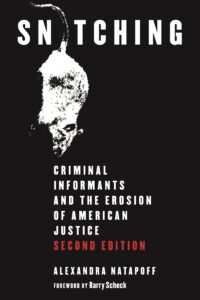Ninety-two-year-old Kathryn Johnston was dead, which meant big trouble for police officers Jason Smith and Gregg Junnier.
Three hours earlier, everything had looked so promising. Atlanta police had busted Fabian Sheats for the third time in four months. In exchange for his release, the local drug dealer-turned-informant had tipped them off to a major stash at 933 Neal Street—an entire kilo of cocaine. Sheats wasn’t one of their registered informants so they couldn’t legally use him to get a warrant, but Smith and Junnier applied for a warrant anyway by inventing an imaginary snitch. They called him a “reliable confidential informant” and told the magistrate judge that this nonexistent snitch had bought crack cocaine at the Neal Street address. The fabrication wouldn’t matter in the end, after they got the warrant, busted in, and grabbed the kilo. It would be a major victory.
___________________________________
Excerpted from Snitching: Criminal Informants and the Erosion of American Justice, Second Edition by Alexandra Natapoff (NYU Press).
___________________________________
But nothing went the way it was supposed to. Sheats’s tip was bad. There was no kilo at 933 Neal Street. Once inside the house, the police opened fire and killed the innocent grandmother who lived there. With no cocaine anywhere to be found, Smith and Junnier turned to one of their regular informants, yet another snitch named Alex White. They offered him $130 to say that he’d bought drugs at Johnston’s Neal Street home and to corroborate their false warrant application. It wouldn’t bring Kathryn Johnston back, but at least no one would learn that they’d gambled everything on a weak lead from a bad snitch and that the informant in the warrant didn’t exist.1
Although it rarely comes to light, criminal informant use is everywhere in the American legal system. Police rely on criminal suspects to get warrants, to perform surveillance, and to justify arrests. Prosecutors negotiate with defendants for information and cooperation, offering to drop charges or lighten sentences in exchange. Especially in the expansive arena of drug enforcement, turning suspects into so-called snitches is a central feature of the way America manages crime, while the secretive practice of trading lenience for information quietly shapes major aspects of our penal process.
In the movies, informants usually show up in high-octane stories about mafia gangsters and drug dealers. But in real life, the practice affects ordinary families and their children. Rachel Hoffman was twenty-three years old and recently graduated from Florida State University. In 2008 she was caught with a small amount of marijuana and a few pills, and Tallahassee police convinced her to become an informant to avoid going to jail. Unbeknownst to her lawyer or family, she agreed to engage in an undercover sting to buy a gun and a large amount of drugs from two criminal targets. During the sting, the targets discovered the wire in her purse. They killed her with the gun she had been sent to buy.
Three years after Rachel Hoffman’s murder, Detroit police caught nineteen-year-old Shelly Hilliard smoking marijuana. Police threatened her with prison, a potentially lethal threat for Hilliard, who was a transgender woman. Hilliard immediately agreed to cooperate and engage in a sting. Within hours of the sting, the dealer-target was released. He tracked Hilliard down and strangled, burned, and dismembered her. “I lost my baby for an ounce of weed,” mourned Hilliard’s mother. “It’s like they just threw her away.”
As stories like these reveal, the use of criminal informants is risky in many ways and for many different stakeholders. It can harm vulnerable informants like Hoffman and Hilliard. It can harm people like Kathryn Johnston who live in neighborhoods where informants are deployed. It invites mistakes, sometimes lethal ones, when the government relies on unreliable sources like Fabian Sheats. It invites official deceit and even corruption when law enforcement officials like Smith and Junnier can operate in secret and without accountability.
At the same time, informants are also a potent crime-fighting tool. They can permit the infiltration of drug cartels, powerful corporations, terrorist conspiracies, and other organizations often impervious to law enforcement. Offering lenience to low-level offenders is sometimes the only way to get information about well-insulated, high-level criminals. From the challenges of organized crime to political corruption, criminal informants can be uniquely productive helpmates for the government.
Informant deals span all kinds of information and cooperation. An especially dangerous yet common version is when law enforcement deploys active criminal informants to generate new arrests and new cases. In Hearne, Texas, for example, a federally funded drug task force swept through town in 2000 and arrested twenty-eight people, mostly Black residents of the Columbus Village public housing project. The task force was relying on the word of informant Derrick Megress, a suicidal former drug dealer on probation facing new burglary charges. Megress had cut a deal with the local prosecutor. If he produced at least twenty arrests, Megress’s new charges would be dropped. He’d also earn one hundred dollars for every person he helped to arrest. One of his innocent victims was waitress Regina Kelly, mother of four, who sat in jail for weeks. Another target, Detra Tindle, was in the hospital giving birth at the time when Megress alleged that she had sold him drugs. A lie detector test finally revealed that Megress had been mixing flour and baking soda with small amounts of cocaine to fabricate evidence of drug deals. Charges against the remaining Hearne suspects were dropped, although several had already pleaded guilty.
The Hearne case was unusual in that it triggered national attention, an ACLU lawsuit, and a film. But it was not an unusual scenario. In 2017, Tina Prater cut a similar deal with local Tennessee police to produce arrests in exchange for cash for her own drug dependency while she was on probation for smuggling drugs into the local jail. Prater fabricated recordings and used fake drugs to allege the sale of illegal pills. Without checking either the recordings or the drugs, police made dozens of arrests before an innocent couple sued the city to stop the practice. When asked by a journalist about the scandal, the local prosecutor shrugged it off: “I’m not saying things aren’t sometimes messy,” he conceded, “but that’s how it happened here.”
The Big Picture
The idea behind “snitching” is simple: a suspect provides incriminating information about someone else in exchange for a deal, maybe the chance to avoid arrest and walk away, or the promise of a lesser charge or sentence. The reality of snitching is complicated: anyone can become an informant, and the government has unfettered discretion over the benefits that it can offer, including money, leniency for past crimes, and the freedom to commit new ones. In exchange, the government can seek nearly anything from its informants, including the demand that they risk their lives. In effect, snitching represents an enormous unregulated market in which the government is authorized to pressure and reward anyone it chooses, in almost any way it pleases, in exchange for almost anything it wants.
As a result of this market flexibility, informant deals are wildly varied. Some are quick and informal. In the “buy, bust, flip” technique, a police officer might release a drug user or dealer like Fabian Sheats in exchange for a tip. Some deals are unconstitutional. In Orange County, California, sheriff deputies strategically placed Mexican Mafia gang members in jail cells next to other defendants and paid the gang members to extract information. Other informant deals are complex, high-profile, and relatively formal. In 2006, corrupt lobbyist Jack Abramoff avoided decades in prison by agreeing to snitch on the politicians he bribed. Fifteen years before that, hit man Salvatore “Sammy the Bull” Gravano testified against mafia boss John Gotti in exchange for drastically reduced punishment and years of witness protection. The unfettered reach and negotiating flexibility of the informant deal has made it a key weapon in the law enforcement arsenal.
Snitching is, in turn, the ubiquitous legal loophole available to even the most serious criminal as a way of escaping liability. The Orange County gang members, Jack Abramoff, and Sammy the Bull all avoided punishment for crimes that the government knew they committed, including drug dealing, racketeering, bribery, and murder.
For these kinds of reasons, using criminal informants exacerbates some of the worst failings of the U.S. criminal system. The practice invites inaccuracy, crime, violence, and sometimes corruption. It inflicts special harms on vulnerable individuals such as poor people of color, individuals with substance use or mental health challenges, and low- income defendants who lack robust legal representation. Because it is secretive and largely unregulated, it evades the traditional checks and balances of judicial and public scrutiny, even as it determines the out- comes of millions of investigations and cases. And finally, like the criminal system itself, the phenomenon is enormous.
Philosophically, the informant deal represents a tense compromise with two core goals of the justice system: crime prevention and proportionate punishment. Informants escape liability for their own crimes when they give information to the government and can even earn the ability to continue offending. Informants may work both ends of the deal, maintaining relationships with the police and turning in other people even as they continue to break the law. In this sense, unlike civilian witnesses, using criminal informants by definition requires the toleration of crime. Indeed, the ability of cooperating drug dealers to remain in business has made snitching a subject of heated debate in communities from Atlanta to East Harlem. The same problem haunts Wall Street where corporate wrongdoers routinely work out cooperation deals to escape prosecution for their multimillion-dollar crimes.
At the same time, the informant deal skews who we punish and how much we punish them. The informant market tends to reward those with the most information to offer, who in turn tend to be more serious or experienced criminals. Minor players, by contrast, have less to trade and therefore, counterintuitively, get punished more harshly. The more culpable are punished less. This is not how criminal justice is supposed to work.
Turning suspects into informants has implications that extend well beyond the criminal process. The practice has political, cultural, even intimate dimensions. For example, when police threatened first-time offender Amy Gepfert with a forty-year sentence for drug distribution, they offered to drop all charges if she had paid sex with another target so that police could charge him with prostitution. She did; no charges were filed against her.
Sometimes the creation of an informant disturbs an entire community. The orthodox Jewish community in Los Angeles was shaken when a prominent member of a well-known congregation turned state’s evidence against a Hasidic rabbi in exchange for lenience in his own fraud case. The betrayal was all the more traumatic because traditional Jewish law prohibits informing against another Jew. Fifty miles south of Los Angeles, the FBI paid fitness instructor Craig Monteilh $11,200 per month to pretend to be Muslim and to infiltrate Southern California mosques and other Muslim organizations. Monteilh—who had a previous conviction for fraud—lost his cover when the Islamic Center of Irvine reported his extremism, ironically, to the FBI and filed a restraining order against him due to his violent jihadist rhetoric.
Informant use disrupts vulnerable communities more than others. Because police make disproportionately more drug arrests in Black neighborhoods, the practice of “flipping” drug arrestees, i.e., turning suspects into snitches, naturally creates more informants in those communities. This means that such neighborhoods must routinely bear the costs of snitching—including informant crime and unreliability. One study, for example, found that innocent Black and Latinx households in San Diego were disproportionately the target of bad search warrants, 80 percent of which relied on confidential informants. Such communities must also contend with friends and neighbors who may be actively seek- ing information in order to “work off ” their own charges.
Because the criminal system occupies such a central place in our social fabric, law enforcement tactics like informant use are not merely penal policies: they are influential features of the way we govern. It is through the penal system that we collectively debate and respond to right and wrong, punish serious wrongdoers, and vindicate victims while simultaneously announcing how we will permit the state to treat its own citizenry. For better or for worse, the criminal system educates the public about the law, about democratic values, and about power. It can instill public confidence or send fear and distrust coursing through a neighborhood.
The penal system, moreover, is a multibillion-dollar industry controlling the lives of the millions of people who are in jail, in prison, and under court supervision. It employs millions of law enforcement workers and influences the local economies of thousands of cities. Over the decades, it has altered the shape of American government itself, investing it with increasingly vast powers to surveil, investigate, coerce, and punish. Using criminal informants is an integral part of this matrix, with many of these same weighty educational, equitable, and gover-nance dimensions.
Our penal system is also famously flawed—harsh, expensive, inaccurate, and unfair. It is the most punitive system on the planet, incarcerating more people than any other nation. It pulls billions of dollars into policing and prisons and away from social services and schools. It is secretive and sloppy, routinely convicting the innocent for the most serious as well as the most minor of crimes. Money matters too much: rich people fare better than poor people. And the system is racially skewed, punishing Black and Latinx people more often and more heavily than whites and deforming the life trajectories of individuals and communities of color. Snitching practices are intimately tied to many of these failings as well.
Understanding the U.S. criminal system in its complex entirety is one of the great challenges of modern legal and social studies; understand- ing criminal informant use is central to that challenge. This is because snitching is paradigmatic of the American criminal system, an extreme expression of three of its key characteristics: discretion, secrecy, and plea bargaining. Like all arrests and prosecutions, informant deals are crafted at the broad discretion of police and prosecutors. Informants are powerful tools of investigation and surveillance, but because their arrangements with the government are mostly confidential, these law enforcement investigative methods are cloaked in secrecy. At the same time, informant deals permit the clandestine resolution of informant liability. In effect, snitch deals are informal, secretive plea bargains: they let the government negotiate and resolve informant criminal guilt and punishment off the books and under the table.
Put differently, the vibrant market for informant deals is possible only because the United States relies so heavily on plea bargaining to resolve the vast majority of criminal cases and U.S. law gives prosecutors such unfettered discretion to do so. Ninety-five percent of all criminal convictions in this country are the result of a plea, not of a trial: this is the dominant legal and market reality within which informant deals take place. Conversely, informant deals strongly shape plea bargaining culture by injecting the theoretical possibility of cooperation into every case, from traffic stops to murder. The pervasive use of such deals, in turn, has transformed key aspects of the adversarial process, including public transparency, the role of defense counsel, trials, and sentencing. Unearthing the full story of informant use is thus revelatory precisely because it uncovers significant, paradigmatic features of the criminal process that usually remain hidden. By understanding snitching, we can learn deep and often disturbing truths about how our entire penal system really functions.
Snitching also offers a powerful opportunity to improve the criminal system. When I wrote the first edition of this book in 2009, there was only a smattering of informant reform at the local, state, and federal levels. I predicted that would change—and it did. Today, more than half of all states have considered or passed significant informant reforms, some of which I have helped to draft. Those reforms span new rules regarding disclosure, tracking, reliability hearings, notice to victims, and protections for vulnerable informants. Chapter 8 describes the trajectory of this reform and documents its many new features.
Informant reform has been fueled by several related developments, most of which involve disruptions to the informant culture of secrecy and impunity. First, the innocence movement has uncovered hundreds of wrongful convictions and revealed the raw unreliability of compensated witnesses who are promised lenience. In 2004, the Northwestern University Center on Wrongful Convictions traced over 45 percent of documented wrongful capital convictions to false informant testimony. This made “snitches the leading cause of wrongful convictions in U.S. capital cases.” In 2015, the National Registry of Exonerations concluded that 23 percent of wrongful capital convictions are due to jailhouse snitches alone. As a result of such revelations, numerous states have passed legislation demanding more accountability from prosecutors who reward their criminal witnesses.
Interest in change has also been prompted by the growing volume of media coverage publicizing the violence, corruption, and injustice that often accompany the use of criminal informants. The New York Times Magazine and ProPublica, for example, jointly published an eye-popping series on jailhouse informants in 2020. It zeroed in on the government’s sordid reliance on a con man named Paul Skalnik to convict dozens of people, including four men who were sent to death row. Skalnik had multiple convictions for fraud; in 1983 he was charged with sexually molesting a seventh-grade girl, but the charges were soon dropped and he was permitted to keep working as an informant.
The popular podcast series In the Dark devoted several episodes to uncovering the government’s heavy reliance on jailhouse informants in the Curtis Flowers murder case. Flowers, a Black man from Mississippi, was vindictively prosecuted six times over the course of twenty years for the same crime despite the lack of any physical evidence against him.
The prosecution relied on multiple jailhouse informants, all of whom claimed that Flowers confessed to them and all of whom later changed their stories. The government’s main informant was Odell Hallmon, who was repeatedly given leniency and released despite facing a broad array of serious criminal charges himself, including an attempt to run over a police officer. In 2016, after testifying four times against Flowers, he went on a shooting rampage and killed three people. In 2018, Hallmon recanted and said his own testimony had been “all make-believe.” The next year, the U.S. Supreme Court overturned Curtis Flowers’s conviction, the government dropped the case, and Flowers was exonerated after spending twenty-three years in prison.
The public has also learned that informants themselves can be victims of the informant market. Spurred in part by the death of Rachel Hoffman, the New Yorker published a groundbreaking exposé of the widespread use and abuse of young informants; 60 Minutes followed up with its own investigation of murdered young informants. In 2014, the University of Massachusetts Amherst was rocked by the fatal heroin overdose of a student named Logan. Logan became an informant for campus police to avoid getting suspended from school. Campus police, in violation of university policy, did not tell Logan’s parents or the university about his substance use disorder and thus prevented him from getting help before he died.
Stories like these over the past decade have opened the door to a deeper public awareness of this clandestine law enforcement practice, its pervasive influence, and its deep flaws. As the debate progresses, it cries out for more and better data. But the criminal system has not been forthcoming. Even with stark evidence of the risks and costs of informant use, law enforcement and prosecutorial practices remain largely undocumented and nonpublic. With a few exceptions described in chapter 8, prosecutors’ offices are not required to document the informant deals they make, the crimes they use informants to solve, or the informant crimes that are forgiven. Likewise, most police departments are not required to keep or report data on their informant use. As a result, public data on informant practices still come largely from sources external to the conventional criminal process: journalism, innocence projects, nonprofit investigations, and advocacy. Much of this disclosure, moreover, is triggered by scandal and tragedy.
The lack of public data flows from the larger culture of secrecy that has long characterized informant use and is explored in chapter 5—“Secret Justice.” The informant deal itself is secretive and informal, typically taking place in unrecorded conversations between suspects and law enforcement. Law enforcement jealously guards its informant practices against disclosure to courts and defendants and sometimes even to other law enforcement agencies. The single most powerful transparency mechanism in the U.S. criminal system is the trial: it is at trial where a defendant becomes legally entitled to information about the informants used against them and the public accordingly gets to learn about those informants too. But this mechanism is inherently limited because most criminal cases in the United States never go to trial, and so the best in- formant disclosure requirements are rarely triggered.
From a policy perspective, the lack of transparency and the paucity of data mean that there can be no meaningful cost-benefit analysis of informant use, only assumptions. The benefits of informant use are well- recognized and mostly taken for granted. It is commonly said, for ex- ample, and I have said it myself, that the FBI could not have dismantled the mafia without using serious criminals as informants—many of them murderers themselves. But the downsides and dangers of those deals remain invisible. We do not know how many other crimes those mafia informants committed, or how many other violent informants were de- ployed and rewarded without producing any law enforcement benefits at all. The same is true for drug informants, street snitches, terrorism informants, and all the other secretive classes of informant whose deals and criminality rarely come to light. As we will see in chapter 7, this invisibility abates somewhat for white collar and public corruption in- formants whose deals and cooperation tend to be formal, lawyered, and publicly documented. But such cases represent a relatively small fraction of the criminal process and thus provide a limited window. In order to move forward, we need to know more.
___________________________________
Excerpted from Snitching: Criminal Informants and the Erosion of American Justice, Second Edition by Alexandra Natapoff (NYU Press).


















